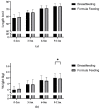Associations between Feeding Patterns and Infant Health in China: A Propensity Score Matching Approach
- PMID: 34960071
- PMCID: PMC8706916
- DOI: 10.3390/nu13124518
Associations between Feeding Patterns and Infant Health in China: A Propensity Score Matching Approach
Abstract
Breastmilk is the optimal food for infants. Feeding pattern is closely related to physical development and health during infancy. Understanding the associations between feeding patterns and health status can inform related policy interventions and advocacy in China. This study aimed to investigate the relationship between infant feeding patterns and health status in China infants. The China National Nutrition and Health Surveillance 2013 was a national-representative cross-sectional study performed particularly for children aged 0-5 years. A total of 3974 infants aged under 1 year were included in the analysis, of whom 1082 (27.2%) made up the formula feeding group, and 2892 (72.8%) made up the breastfeeding group. The associations between feeding patterns and physical development and health were investigated using propensity score matching and multivariable logistic regression models. Among breastfeeding and formula feeding infants aged 9-11 months old, weight-for-age z score was 1.1 ± 1.1 and 0.9 ± 1.3, respectively, and weight-for-length z score was 1.0 ± 1.3 and 0.7 ± 1.4, respectively. Hemoglobin in 0-2, 3-5, 6-8, and 9-11 months old breastfeeding infants was 121.4 ± 15.2 g/L, 117.1 ± 13.0 g/L, 113. 9 ± 11.9 g/L, and 114.4 ± 14.0 g/L, while in 0-2, 3-5, 6-8, and 9-11 months formula feeding infants was 116.3 ± 14.8 g/L, 120.4 ± 11.3 g/L, 119.8 ± 11.2 g/L, and 120.0 ± 11.5 g/L, respectively. Breastfeeding was associated with lower risk of respiratory disease (OR: 0.79; 95% CI: 0.64, 0.99) and diarrhea (OR: 0.75; 95% CI: 0.57, 0.98). Breastfeeding could slightly improve infant physical development, and had a protective effect on the diarrheal and respiratory diseases. Infants aged 3-11 months who were breastfeeding showed lower hemoglobin than that of formula-fed infants and thus should increase intake of iron rich complementary foods.
Keywords: cross-sectional study; feeding pattern; infant; propensity score matching.
Conflict of interest statement
The authors declare no conflict of interest.
Figures



Similar articles
-
Associations between infant and young child feeding practices and acute respiratory infection and diarrhoea in Ethiopia: A propensity score matching approach.PLoS One. 2020 Apr 1;15(4):e0230978. doi: 10.1371/journal.pone.0230978. eCollection 2020. PLoS One. 2020. PMID: 32236145 Free PMC article.
-
Exclusive Breastfeeding Rate and Complementary Feeding Indicators in China: A National Representative Survey in 2013.Nutrients. 2018 Feb 22;10(2):249. doi: 10.3390/nu10020249. Nutrients. 2018. PMID: 29470415 Free PMC article.
-
Associations of infant feeding with trajectories of body composition and growth.Am J Clin Nutr. 2017 Aug;106(2):491-498. doi: 10.3945/ajcn.116.151126. Epub 2017 Jun 28. Am J Clin Nutr. 2017. PMID: 28659299 Free PMC article.
-
Nutrition, growth, and allergic diseases among very preterm infants after hospital discharge.Dan Med J. 2013 Feb;60(2):B4588. Dan Med J. 2013. PMID: 23461996 Review.
-
Role of breast-feeding in the prevention and treatment of diarrhoea.J Diarrhoeal Dis Res. 1990 Sep;8(3):68-81. J Diarrhoeal Dis Res. 1990. PMID: 2243179 Review.
Cited by
-
The global burden of childhood diarrheal diseases attributable to suboptimal breastfeeding from 1990 to 2021: an exploratory analysis of estimates from the global burden of disease study.Int Breastfeed J. 2025 Mar 26;20(1):19. doi: 10.1186/s13006-025-00713-9. Int Breastfeed J. 2025. PMID: 40140930 Free PMC article.
-
Effects of feeding patterns during the first 6 months on weight development of infants ages 0-12 months: a longitudinal study.Sci Rep. 2024 Jul 29;14(1):17451. doi: 10.1038/s41598-024-58164-x. Sci Rep. 2024. PMID: 39075043 Free PMC article.
-
Effect of Teté dance on lactation session duration in irritable infants in peru assessed in a randomized controlled trial.Sci Rep. 2025 Mar 21;15(1):9808. doi: 10.1038/s41598-025-95236-y. Sci Rep. 2025. PMID: 40119115 Free PMC article. Clinical Trial.
-
Factors Associated with Anthropometry Z-Scores in Exclusively Breastfed Infants Aged 0-6 Months in 10 Cities of China.Nutrients. 2025 Jun 29;17(13):2163. doi: 10.3390/nu17132163. Nutrients. 2025. PMID: 40647268 Free PMC article.
References
-
- Gartner L.M., Morton J., Lawrence R.A., Naylor A.J., O’Hare D., Schanler R.J., Eidelman A.I. Breastfeeding and the use of human milk. Pediatrics. 2005;115:496–506. - PubMed
-
- Davisse-Paturet C., Adel-Patient K., Divaret-Chauveau A., Pierson J., Lioret S., Cheminat M., Dufourg M., Charles M., de Lauzon-Guillain B. Breastfeeding Status and Duration and Infections, Hospitalizations for Infections, and Antibiotic Use in the First Two Years of Life in the ELFE Cohort. Nutrients. 2019;11:1607. doi: 10.3390/nu11071607. - DOI - PMC - PubMed
MeSH terms
Grants and funding
LinkOut - more resources
Full Text Sources
Medical

